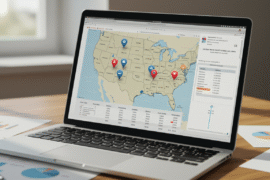This article may contain references to products or services from one or more of our advertisers or partners. We may receive compensation when you click on links to those products or services. Nonetheless, our opinions are our own.
The information presented in this article is accurate to the best of our knowledge at the time of publication. However, information is subject to change, and no guarantees are made about the continued accuracy or completeness of this content after its publication date.
- Summary of Highlights
- Introduction
- General Liability and Unique Risks for Thrift Stores
- Common Hazards in Thrift Store Environments
- Impact of Secondhand Inventory on Liability
- Essential Insurance Policies for Thrift-Clothing Stores
- Managing Costs and Choosing the Right Insurer
- Final Thoughts
- Frequently Asked Questions
- Recommended Reads
Summary of Highlights
- General liability insurance covers injuries or accidental damage claims in the store.
- Property insurance protects the store’s assets and inventory from theft, fire, or damage.
- Product liability insurance covers legal fees if customers are harmed by sold items.
- A Business Owner’s Policy (BOP) bundles important coverages like property and liability insurance at a lower cost.
- Insurance shields owners from common store risks such as employee injuries or unexpected expenses.
- Comparing multiple free quotes online helps find affordable and suitable coverage.
Introduction
Running a thrift-clothing store involves unique challenges and risks typical to retail businesses. Proper insurance, such as general liability and related coverages, provides financial protection if incidents occur, like customer injuries, property damage, or legal issues. Having the right insurance allows owners to focus on delivering quality used clothing without worrying about unexpected setbacks.
General Liability and Unique Risks for Thrift Stores
Thrift-clothing stores combine environmental care with affordable shopping. Managing products, satisfying customers, and ensuring employee safety can be demanding. Selling used items introduces specific uncertainties compared to new merchandise. Retail risks include theft, injuries, and property damage. Insurance tailored to these factors helps thrift stores handle such challenges.
Common Hazards in Thrift Store Environments
Hazards often arise from accidents like trips over clutter or slips on wet floors, leading to claims against the business. General liability insurance covers medical and legal costs related to these incidents. Work-related injuries from lifting or sorting clothes are common and addressed through workers’ compensation insurance. Property damage from fire, leaks, or vandalism can disrupt operations, but property insurance provides funds to recover quickly.
Voted "Best Overall Budgeting App" by Forbes and WSJ
Monarch Money helps you budget, track spending, set goals, and plan your financial future—all in one app.
Get 50% OFF your first year with code MONARCHVIP
Impact of Secondhand Inventory on Liability
Used clothing may carry risks such as causing skin irritation or other injuries if not properly cleaned. Product liability insurance assists with legal fees and settlements in these cases. Mislabeling items can also lead to customer dissatisfaction or harm, increasing legal expenses. Having product liability coverage protects the business’s finances and reputation.
Essential Insurance Policies for Thrift-Clothing Stores
Starting with general liability and property insurance addresses major risks. A Business Owner’s Policy (BOP) combines these coverages in one affordable package, simplifying protection for small thrift stores.
General Liability Insurance for Customer Injuries and Damages
General liability insurance helps cover costs if customers are injured or their property is damaged on site. It also provides required proof of insurance for leases or contracts. This coverage includes:
- Medical bills for injuries occurring in the store
- Reimbursement for damaged customer property
- Legal defense and settlement payments
Business Owner’s Policy (BOP) for Combined Coverage
A BOP offers a bundled solution including general liability, property insurance, and business interruption coverage. Working with licensed agents ensures the plan matches store needs and budget.
Specialized Coverage Considerations
Some thrift stores require additional protection, such as commercial umbrella insurance for high-cost lawsuits or policies covering volunteers and off-site risks. Consulting insurance experts helps customize policies for evolving retail environments.
Product Liability for Used Apparel
Used items can lead to lawsuits if customers are harmed by defective or poorly maintained products. Product liability insurance covers legal and settlement costs, protecting thrift stores from financial strain. Mislabeling risks also fall under this coverage.
Property Insurance for Storefronts and Inventory
Property insurance protects the physical store, fixtures, and merchandise against events like fire, theft, or vandalism. Business interruption coverage reimburses lost income during closures caused by covered incidents.
| Insurance Feature | Coverage Description |
|---|---|
| Business Property | Covers storefront, fixtures, and equipment against covered risks |
| Inventory Coverage | Protects merchandise from theft, fire, or other insured events |
| Business Interruption | Reimburses income loss during store closures caused by covered events |
These protections help stores recover quickly and maintain stability during disruptions.
Managing Costs and Choosing the Right Insurer
Balancing adequate insurance with affordability is critical. Free online quotes allow thrift store owners to compare prices and coverage options. Insurance agents can guide small businesses in selecting plans suited to common retail risks while fitting budgets.
- Number of employees or owner-operated status
- Store size and inventory value
- History of claims and known risks
For example, stores with more employees generally face higher premiums due to increased risk exposure. Using online tools helps identify the best fit and price.
How to Compare Insurance Providers in the U.S.
Look for:
- Competitive premium rates
- Comprehensive property and liability coverage
- Easy access to proof of insurance documents
Choose insurers experienced with retail policies. Review customer feedback and verify coverage options and responsiveness. Reliable providers ensure compliance with business requirements and reduce worries.
Final Thoughts
Proper insurance is vital for thrift-clothing stores to protect against common risks such as injuries and product-related issues. With informed choices and trusted agents, owners can create coverage plans that support business growth and resilience. Assess options carefully to secure the protection needed for lasting success.
Frequently Asked Questions
Do thrift stores need different insurance than new clothing stores?
Yes. Thrift stores face unique risks related to selling used items, making specialized resale insurance important.
Does insurance cover donated or consigned goods?
Usually, yes. Property insurance often includes donated or consigned items if they are part of the insured inventory. Confirm specifics with providers.
What if a customer is hurt by a used item?
Product liability insurance covers legal and medical costs from such claims, protecting businesses selling used clothing.
Are employees and volunteers covered by thrift store insurance?
Yes. Workers’ compensation covers medical bills for job-related injuries for both employees and volunteers. Liability coverage may address claims related to work performance.
Compare free quotes, adjust coverage limits, implement risk management practices, and work with knowledgeable agents to find fair pricing and suitable protection.

Reviewed and edited by Albert Fang.
See a typo or want to suggest an edit/revision to the content? Use the contact us form to provide feedback.
At FangWallet, we value editorial integrity and open collaboration in curating quality content for readers to enjoy. Much appreciated for the assist.
Did you like our article and find it insightful? We encourage sharing the article link with family and friends to benefit as well - better yet, sharing on social media. Thank you for the support! 🍉
Article Title: Insurance for Thrift-Clothing Stores
https://fangwallet.com/2025/06/10/insurance-for-thrift-clothing-stores/The FangWallet Promise
FangWallet is an editorially independent resource - founded on breaking down challenging financial concepts for anyone to understand since 2014. While we adhere to editorial integrity, note that this post may contain references to products from our partners.
The FangWallet promise is always to have your best interest in mind and be transparent and honest about the financial picture.
Become an Insider

Subscribe to get a free daily budget planner printable to help get your money on track!
Make passive money the right way. No spam.
Editorial Disclaimer: The editorial content on this page is not provided by any of the companies mentioned. The opinions expressed here are the author's alone.
The content of this website is for informational purposes only and does not represent investment advice, or an offer or solicitation to buy or sell any security, investment, or product. Investors are encouraged to do their own due diligence, and, if necessary, consult professional advising before making any investment decisions. Investing involves a high degree of risk, and financial losses may occur including the potential loss of principal.
Source Citation References:
+ Inspo
There are no additional citations or references to note for this article at this time.












































